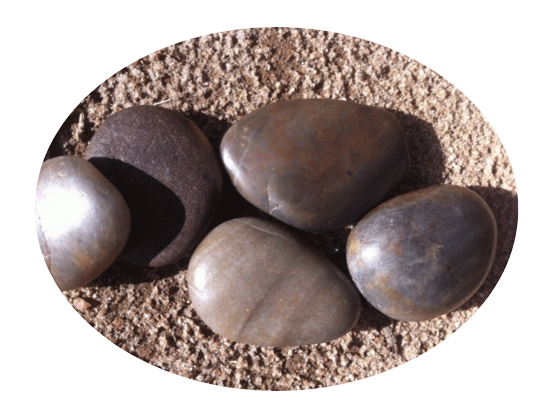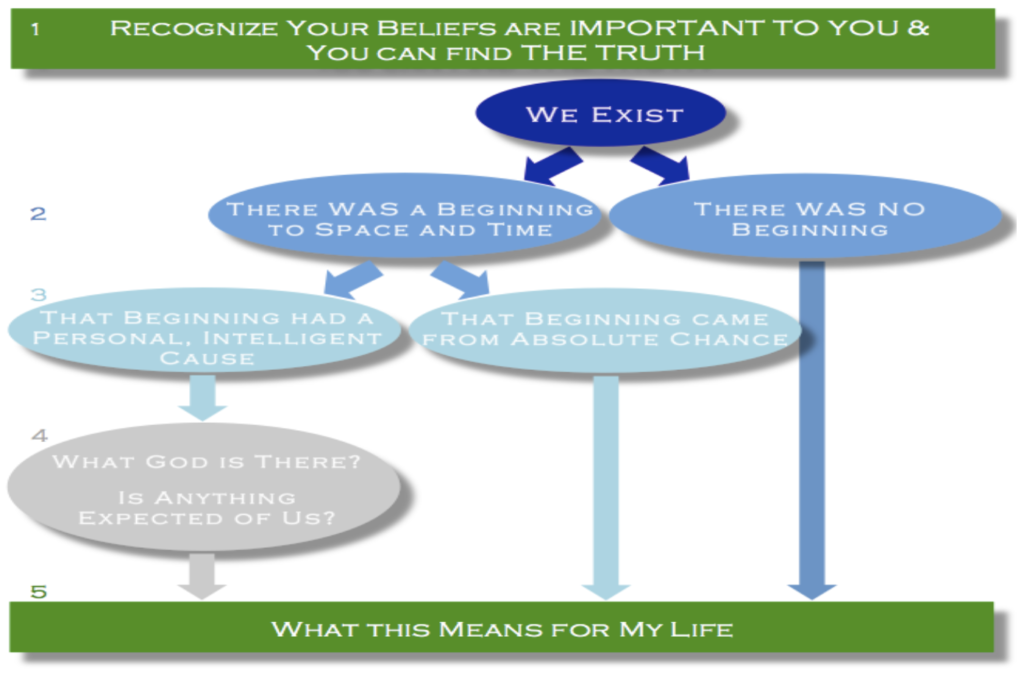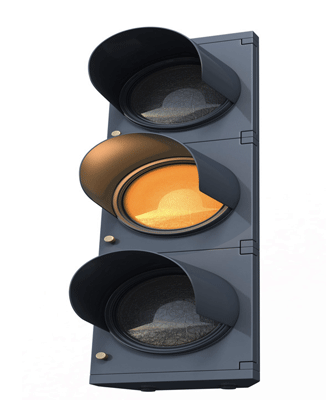Answer: The same way we know with other decisions in life.
This method is simple, proven, and we use it naturally every day.
A – RECOGNIZE WHERE YOU STAND & HOW SERIOUS and impactful the decision is
B – Follow the SAME PROBLEM-SOLVING STEPS you use for any important issue
C – Then, this is HOW WE KNOW
A – RECOGNIZE WHERE YOU STAND & HOW SERIOUS and impactful the decision is
- You are currently directing your life overall, using a specific worldview map
- This brings a quantity & quality of impacts that are as serious as it gets
- Wherever different worldview beliefs contradict each other, only 1, at most, can fit reality, be true, and guide you accurately.
- There will be a time for all of us, when either truth will welcome us home with correct guidance to expected results, or we will fall from our beliefs, which are not supported by reality, into an unyielding, unexpected truth.
So how do we know we are using an accurate map to direct our choices, responses, goals and future? How do we know we are not in serious need of a more accurate map? The answer is the same whether you are walking a path, or making a choice in life – there are guideposts. Worldviews are claims about reality, and therefore can be tested for truth. Tests serve as guideposts, in science, theology, and in our everyday life.
Researchers in every area of study have continually ventured down every possible path to search for signs (tests for truth) serving as a guide to the correct path – and many guideposts have been and continue to be found – how we naturally find these guideposts is part B, and how we use them is found in part C of this article. Right now, we will consider one sample of a straight-forward way to approach the big question of beliefs.
What worldview fits reality – which one is true – you can check

The question of beliefs can seem overwhelming, with all the information, misinformation, opinions, etc. However, there are a number of useful approaches to effectively reach accurate conclusions about which worldview(s) fit reality, and which do not. I prefer my 5 Smooth Stones approach, summarized below, for two reasons: it is simple (notice only two possible options for half the steps), and the evidence is already in (a continuous flow of evidence has smoothed & hardened the 5 steps) to provide solid guidance to accurate answers.

B- Follow the same PROBLEM-SOLVING STEPS you use for any important issue
When I bring up the scientific method, or problem-solving steps, I can just see the eyes of those who aren’t into science, drift away into daydreaming. But you don’t need to memorize the terms or have any inclination for science, as we all use these steps every day, naturally, since childhood.
In fact, one of the earliest memories I have involves a perfect example. I was on a class field trip and so young that the eight of us were all holding hands with each other, during the entire time at a museum. We sat down in a circle, still holding hands, with myself at one end, the teacher in the middle, and the last student at the other end holding the hand of the museum worker, who was reading us a story.
Almost immediately I lost interest in the story, and noticed there was an open electrical outlet on the wall next to me. The memory is so clear to this day how within moments I went through the basic scientific method:
Step 1 & 2. Observation/Question: if I jam my fingers into the exposed outlet, will the shock just get me, or will it make it all the way to that museum reader?
Step 3. Hypothesis: my past history taught touching some objects to electric fences will shock me, and my mom gave a brief physics lesson noting electricity can travel through some things, so it may make it through a line of connected people. I included views from science, personal history, even ethics, but failed to place much weight on ethics.
Step 4. Test and Data: jamming my fingers into the open-ended wires in the outlet sent a back-straightening jolt through the line of us, and terminated with the unsuspecting museum employee.
Step 5. Analysis: my hypothesis was correct, and totally worth the effort.
Since childhood we naturally and efficiently integrate different sources of knowledge, when facing a problem to solve, or decision to make. Here is a description of those steps.
Step 1. PROBLEM OR OBSERVATION
You face some problem, or encounter something you have a question about.
Step 2. ASK A QUESTION(S)
You ask a question based on the problem, or what you encountered.
Step 3. HYPOTHESIS/MODEL
Based on what you already know, what is your guess at the correct answer to the question. A hypothesis is an educated guess at the answer, while a model is more a set of hypotheses. Your worldview beliefs are a model about reality.
Step 4. TEST HYPOTHESIS/MODEL
It is not necessary for you to know all the in’s & out’s of different types of reasoning or experimentation, just living life and being open and wanting truth will bring much of the evidence to you. Here are some sources of information:
| Tool | Method | Reliability on providing Truth |
| (a) Philosophical Reasons | Rules for correct approaches to thinking. Deductive proofs, Inductive & Abductive thinking. | Very good, if done correctly |
| (b) Experience | Your own personal history, observation, and record of experiences. | Good, but limited by your experience & can be impacted by other factors, e.g., (d) |
| (c) Science | The scientific method. | Very good, if correct, appropriate testing & interpretation of results |
| (d) Feelings, Personal Preferences, Psychological | Your emotional response or psychological causes from the past and/or at the moment. Your wants/desires driving your beliefs, instead of the reverse. | Weak, different people, or even the same person, can be led to contradictory beliefs by feelings, wants, etc., none of which change the truth of the situation |
| (e) Sincerity | You honestly, genuinely, and maybe strongly believe it. | Weak, same reason as for feelings. |
| (f) Theology | Study of areas relating to God, and/or knowledge provided by a divine authority or “enlightened” person(s) | The strongest, if God exists & we received the communication correctly. |
| (g) Upbringing | Where you were brought up, by whom, how you were taught, etc. | Weak, people can be led to contradictory beliefs by upbringing. |
| (h) History | Study of events and people of the past. | Very good, if done correctly. |
| (i) “Experts,” Professors, Religious or academic Teachers | Have significant training and spent much of their career in a specific area. So we expect their research, skill, and time investment to provide insights. | Good & Questionable, it is a logical fallacy to claim something is true due to expert testimony, and experts often make claims that go beyond their area of expertise, but “experts”, once their support has been checked, can provide reliable evidence. |
| (j) Astrology | Using your birthdate, the alignment of stars, and other entirely disconnected stuff. | Absolutely worthless. I can do an experiment to prove this. |
| (k) Others | For example, Internet – check the background & support, same as with “experts.” | Can be as good as (i), can be as weak as (j). |
Step 5. COLLECT & ANALYZE RESULTS
To do this step correctly, you must approach the information gathered honestly, and avoiding the PERSONAL OBSTACLES that distract you, or lead you to a wrong conclusion because it is easier or more comfortable. You then are able to use RECOGNIZED STANDARDS for judging any theory/hypothesis/model/belief.
The personal obstacles are sneaky, and actually so interesting this topic is covered in it’s own article How Stupid are We? But the standards used to judge a hypothesis, or scientific model or belief, are well-established and will be covered in the next section.
Step 6. CONCLUSION & REPEAT THE PROCESS & REVISE AS NEEDED
Does the evidence support/reject/revise any models? Repeat the process as often as necessary to reach a well-supported conclusion. An accurate model will not only display robust verification when tested, but you will see (beyond all the different opinions, personal preferences, information, misinformation, etc.) a trend of evidence pointing to the model matching reality.
Step 7. COMMUNICATE & EXPAND THE RESULTS
Sharing your findings with others is a step of paramount importance in science and life, as it can benefit others and promote further progress.

An example: You are approaching a yellow light . . .
- YOU NATURALLY USE EMPIRICAL SCIENCE from data you
have gathered through your driving, and determine
whether you could stop in time at your current speed, or not.
- You have no time for a PHYSICS calculation, but you do consider velocity, momentum, and road condition’s impact on stopping.
- You make an ESTIMATE of “how red” the light will be by the time you are going under it.
- You use ETHICAL PHILOSOPHY, knowing the law says stop, and someone could get hurt if you go through a red light, or if you slam the brakes and slide out of control.
- You use OBSERVATION and HISTORICAL knowledge to determine the likelihood of the police being nearby, and what were the results from your past situations like this.
- You use LOGIC to put all of the facts together and try to make a rational choice in the short time you have to decide.
This problem-solving method is natural stuff you practice every day, and we will use the same approach to face the choices of different beliefs.
C- HOW Can We KNOW?
The same way we know with other theories or choices in life
If you expect to “know”, meaning know with absolute certainty your worldview belief is true, then you need to check out “Can I know for certain?” in the FAQs section. For now, how do we evaluate different models/theories/choices/beliefs? What are the objective standards used? For example, is the Earth flat or round: Aristotle used philosophy by noting all stuff of the earth would tend toward the center, eventually resulting in a sphere; even people in ancient times could see the Earth’s shape during a lunar eclipse; those on an ocean can note the curved horizon; later people circumnavigated the globe; there were a variety of evidences. A round Earth fits EETTCCA (see below) much better than a flat earth.
a) Explanatory power (how well does the model explain the evidence/facts)
b) Explanatory scope (how much does the model accurately explain)
c) Testability, especially predictability (Provides claims/predictions that can be tested and verified or falsified)
d) Trends (as more answers come in, does the model’s support trend up or down)
e) Cumulative case (best evidence from all relevant sources combined)
f) Coherent answers (to all the biggest questions in life)
- Avoids poor logic (unwarranted assumptions, unsupported points, logical inconsistencies, use of avoidance, ad hoc, etc.)
In other words, what model best fits the facts, best explains what we know about the universe and life, does not have core beliefs lacking supportive evidence, provides claims (especially predictions) we can test,
| Life’s Biggest Questions |
| 1) Origin: Where did it all come from? |
| 2) Meaning: Why are we here, does my life have any meaning/purpose/value? What is most important in my life? |
| 3) Cause: Does God exist? If so, what God is it, or is there no god, or is the answer unknowable? |
| 4) Choices: Is there true right & wrong? Are there really decisions that are the best for me? What is my current condition, and can I reach something better? |
| 5) Destination: Is there something after this life? |
and the evidence from all fields of study and the trends of further discovery point directly to its accuracy.
These are standards historians, scientists, attorneys, crime scene investigators (CSI), logicians, and everyone associated with evaluating evidence have relied upon. And using these same standards, it is extraordinary how far separated the biblical option stands from all other theories, which is explored in the So, Now What? section of the website (thoughtfulbeliefs.org) where the different worldview beliefs you can choose from are explained, compared and tested.
Once you A) RECOGNIZE WHERE YOU STAND & HOW SERIOUS and impactful the decision is, and B) Realize you can just use THE SAME PROBLEM-SOLVING STEPS you use for any important issue, and C) Evaluate the different beliefs using the SAME TESTS TO KNOW which belief is true as is used with any theory, model, or choice in life, then we need to understand one more thing to ensure our decision is best … AVOID PERSONAL OBSTACLES that can divert judgment from the best life choice, which is covered in the next How Stupid are We? article.
After that, and running a check on “yo self,” time to jump into the really interesting stuff: Where is the Evidence? Section of the website.

